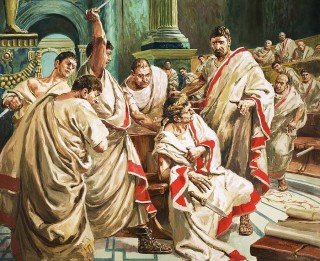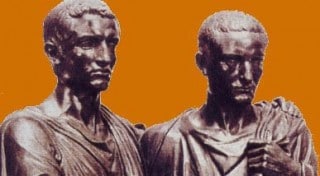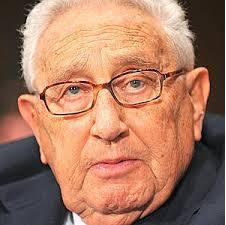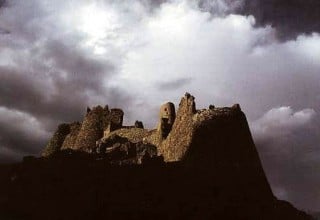“They’ll talk about change, about politics, about reform, about corruption, but they will never talk about war unless they mean something happening far away. Because to admit the existence of the war waged against us is to admit that we are combatants, and if we see that we are not fighting back, then we would have to admit that we have surrendered. That we have already been defeated.”—The Arctic Circle Collective
“The destruction of seven countries in whole or in part by the West in the 21st century, with the support of ‘Western civilization’ and the Western media, comprises powerful evidence that the leadership of the Western world is devoid of moral conscience and human compassion. Now that Washington is armed with its false doctrine of ‘nuclear primacy,’ the outlook for humanity is very bleak.”–Dr. Paul Craig Roberts (2014)
Summary: One day in the not-too-distant future, dissidents might choose to fight back against the criminal syndicate that rules most of the world now. On that day, everything would depend on the strategy they choose. To avert slavery, perpetual war, obscene income inequalities, moral and spiritual decay, brazen corruption, environmental degradation, and perhaps even human extinction, they might contemplate copying the syndicate’s own effective strategy of bullying, blackmailing, and killing influential opponents. The present article provides a brief historical sketch of that strategy.
by Moti Nissani
In the Ancient World, Empires and Rulers Safeguarded their Power and Privileges by Assassinating Influential Opponents
Roman oligarchs relied, among other things, on murders to safeguard their disproportionate power and wealth. In the long run, their success led to the moral, spiritual, economic, and political decline of their country.

The standard version of the assassination of Julius Caesar (e.g., Shakespeare’s Julius Caesar) alleges that the oligarchic conspirators sought to restore republican liberties. A careful study of the historical record led Michael Parenti[1] to the credible view that Brutus, Cassius, and their fellow conspirators–just like David Rockefeller, Evelyn Rothschild and underlings such as Soros, Gates, Buffet, Kissinger, or Brzezinski today–sought more power and privileges for themselves and less for the vast majority of their countrymen.
“In word and action, wealthy Romans made no secret of their fear and hatred of the common people and of anyone else who infringed upon their class prerogatives. History is full of examples of politico-economic elites who equate any challenge to their privileged social order as a challenge to all social order, an invitation to chaos and perdition.
“The oligarchs of Rome were no exception. Steeped in utter opulence and luxury, they remained forever inhospitable to Rome’s democratic element. They valued the Republic only as long as it served their way of life. They dismissed as ‘demagogues’ and ‘usurpers’ the dedicated leaders who took up the popular cause. . . .
“Caesar’s sin . . . was not that he was subverting the Roman constitution–which was an unwritten one–but that he was loosening the oligarchy’s overbearing grip on it. Worse still, he used state power to effect some limited benefits for small farmers, debtors, and urban proletariat, at the expense of the wealthy few. No matter how limited these reforms proved to be, the oligarchs never forgave him. And so Caesar met the same fate as other Roman reformers before him.”
Here is a less controversial example:[2]
“The Gracchi, Tiberius Gracchus and Gaius Gracchus, were Roman brothers who tried to reform Rome’s social and political structure to help the lower classes, in the 2nd century B.C.
“Events surrounding the politics of the Gracchi led to the decline and eventual fall of the Roman Republic. From the Gracchi to the end of the Roman Republic, personalities dominated Roman politics; major battles were not with foreign powers, but civil.

“To Tiberius Gracchus, the biggest problem was that there were not enough small farmers. He wanted to give land to some of the many free, poor unemployed. These men would be happy to farm, but there wasn’t enough land, so he proposed that the state should take over land held illegally by large landholders and distribute it to the poor. Unfortunately for the plan of Tiberius, the people illegally holding the land were the powerful nobles whose families had held the land for generations. Theydidn’t want to give it up.
“In 133 Tiberius Gracchus was killed during rioting. Gaius Gracchus took up the reform issues of his brother when he became tribune in 123 B.C., 10 years after the death of brother Tiberius. He created a coalition of poor free men and equestrians who were willing to go along with his proposals. His political successes enraged the nobles. Gaius Gracchus lost control of his coalition and, faced with armed opposition, fell on a slave’s sword.”
In the Contemporary World too, Empires and Rulers Safeguard their Power and Privileges by Selective Targeting
A. Noboru Takeshita of Japan[3]
“The worst case of the murder of a Japanese Prime Minister, though, definitely is the story of what happened to Prime Minister Noboru Takeshita. According to two independent sources, one a member of the Japanese royal family and another a high ranking public security police official, Takeshita was taken to Alaska by thugs working for the US corporate government.
“There he was chased naked in the snow by a helicopter before he was beaten to death and had his testicles crushed, they concur. A video of his murder was shown to high level Japanese power brokers as a warning of what would happen if they tried the same. Takeshita’s big crime, as was the case with Hashimoto, was to discuss in public the possibility of selling off some of Japan’s US government bond holdings. The official story is that Takeshita ‘died in the hospital.’”
B. Martin Luther King of the USA[4]
”According to a Memphis jury’s verdict on December 8, 1999, in the wrongful death lawsuit of the King family versus Loyd Jowers ‘and other unknown co-conspirators,’ Dr. Martin Luther King Jr. was assassinated by a conspiracy that included agencies of his own government. Almost 32 years after King’s murder at the Lorraine Motel in Memphis on April 4, 1968, a court extended the circle of responsibility for the assassination beyond the late scapegoat James Earl Ray to the United States government.
“What I experienced in that courtroom ranged from inspiration at the courage of the Kings, their lawyer-investigator William F. Pepper, and the witnesses, to amazement at the government’s carefully interwoven plot to kill Dr. King. The seriousness with which U.S. intelligence agencies planned the murder of Martin Luther King Jr. speaks eloquently of the threat Kingian nonviolence represented to the powers that be in the spring of 1968.
“Thanks to the conjunction of a civil court, an independent judge with a sense of history, and a courageous family and lawyer, a spiritual breakthrough to an unspeakable truth occurred in Memphis.”
C. Rene Schneider and Salvador Allende of Chile[5]
The last example shows in greater detail how two Rockefeller’s protégés terrorized an entire nation.
“As journalist William Blum notes, there’s one thing the United States hates more than a Marxist in power, and that’s a democratically elected Marxist in power. A prime example was Salvador Allende of Chile. September 4 [2001] marks 31 years since his election. September 11 [9/11] marks 28 years since his death in a U.S.-sponsored coup.
“’I don’t see why we need to stand by and watch a country go communist because of the irresponsibility of its own people.’—Henry Kissinger, June 27, 1970
“Salvador Allende, a physician by trade, first gained worldwide attention when he came within three percent of winning Chile’s 1958 presidential election. Six years later, the United States decided to no longer leave such elections to chance. It was time to introduce the Chilean people to democracy, American-style.
“The U.S. government, mostly through the covert efforts of the Central Intelligence Agency, spent more money per capita to support Allende’s opponent, Eduardo Frei, than Lyndon Johnson and Barry Goldwater combined spent that same year in the American presidential election.
“With an estimated $20 million of U.S. taxpayer money to work with, the CIA embarked on a program of anti-communist propaganda and disinformation designed to scare Chilean citizens — specifically mothers — into believing that an Allende victory would result in direct Russian control of their country and their lives. ‘No religious activity would be possible,’ they were told. Their children, hammer and sickle stamped on their foreheads, would be shipped to the USSR to be used as slaves, the radio and newspapers direly warned.
“The scare tactics worked. While Allende won the male vote by a small margin, 469,000 more Chilean women chose Frei. Cleverly manipulated to fear the ‘blood and pain’ of ‘godless, atheist communism,’ the mothers of Chile voted against the man who promised to ‘redistribute income and reshape the . . . economy’ through the nationalization of some major industries, like copper mining, and the expansion of agrarian reform. A far cry from Leninism, Allende’s policy of ‘eurocommunism,’ i.e., communists linking with social democratic parties into a united front, was for the most part, as unacceptable to the Kremlin as it was to the White House.
“When the 1970 Chilean presidential election rolled around, Allende was still a major player. However, he had a new and powerful enemy: Dr. Henry Kissinger.
“Despite another wave of U.S.-funded propaganda, Salvador Allende was elected president of South America’s longest functioning democracy on Sept. 4, 1970. Henry Kissinger (HK) and his cohorts had to act. The 40 Committee was formed with HK as chair. The goal was not only to save Chile from its irresponsible populace but to yet again stave off the red tide. . .
“At a Sept. 15 meeting called to halt the spread of infection, Kissinger and President Nixon told CIA Director Richard Helms it would be necessary to ‘make the [Chilean] economy scream.’ While allocating at least $10 million to assist in sabotaging Allende’s presidency, outright assassination was also considered a serious and welcome option.
“The respect held by the Chilean military for the democratic process led Kissinger to pick as his first assassination target not Allende himself, but General Rene Schneider, head of the Chilean Armed Forces. Schneider, it seems, had long believed that politics and the military should remain discrete. Despite warnings from Helms that a coup might not be possible in such a stable democracy, HK urged the plan to proceed.
“’Kissinger had direct personal knowledge of the CIA’s plan to kidnap and murder Schneider,’ declares journalist Christopher Hitchens. ‘This was one of the relatively few times when Mr. Kissinger involved himself in the assassination of a single named individual rather than the slaughter of anonymous thousands.’
“When the killing of Schneider only served to solidify Allende’s support, a CIA-sponsored media blitz similar to that of 1964 commenced. Citizens were faced with daily “reports” of Marxist atrocities and Soviet bases supposedly being built in Chile. U.S. threats to sever economic and military aid were also used to help cultivate a ‘coup climate’ among those in the military. These two approaches represented the hard and soft lines outlined by Nixon and HK.
“How soft was soft? Edward Korry, U.S. ambassador to Chile at the time, articulated the soft sell by declaring that the U.S. task was ‘to do all within our power to condemn Chile and the Chileans to utmost deprivation and poverty.’ Korry warned, ‘not a nut or bolt [will] be allowed to reach Chile under Allende.’
“On the hard side, Dr. Henry began securing support for a possible military coup.
“’In 1970,’ writes historian Howard Zinn, ‘an ITT director, John McCone, who had also been head of the CIA, told Kissinger and Helms that ITT was willing to give $1 million to help the U.S. government in its plans to overthrow the Allende government.’
“’The stage was set for a clash of two experiments,’ says Blum. Allende’s socialism was pitted against what was later called a ‘prototype or laboratory experiment to test the techniques of heavy financial investment in an effort to discredit and bring down a government.’ This clash would reach its climax on Sept. 11, 1973.
“The socialist experiment ended in violence on that day and Allende himself was said to have committed suicide . . . with a machine gun. Of course, the U.S. claimed no complicity in or even knowledge of the coup at the time. However, when the State Department declassified 5000 documents in 1999, a different story was told.
“For example, a CIA document from the day before the coup stated bluntly, ‘The coup attempt will begin September 11.’ Ten days later, the Agency announced, ‘severe repression is planned.’ With thousands of opponents of the new regime gathered in soccer stadiums, a Sept. 28 State Department document detailed a request from Chile’s new defense minister for Washington to send an expert advisor on detention centers.
“Allende was dead. In his place, the people of Chile now faced brutal repression and human rights violations, book burnings, dogs trained to sexually molest females, a powerful secret police, and more than 3000 executions. Tens of thousands more were tortured and/or disappeared. Shortly after the coup, U.S. economic and military aid once again began to flow into Chile.
“The man in charge of all this was General Augusto Pinochet, a man Dr. Kissinger could really get behind. ‘In the United States, as you know, we are sympathetic to what you are trying to do,’ HK told the Chilean dictator in 1975. ‘We wish your government well.’
“’My evaluation,’ he continued to Pinochet, ‘is that you are the victim of all the left-wing groups around the world and that your greatest sin was that you overthrew a government that was going communist.’ Later that same year, when facing a roomful of Chilean diplomats concerned about the effect Pinochet’s human rights violations might have on world opinion, Henry was in top form:
“’Well, I read the briefing paper for this meeting and it was nothing but human rights. The State Department is made up of people who have a vocation for the ministry. Because there were not enough churches for them, they went into the Department of State.’

“Was HK really that concerned with the minor nationalization of industry proposed by Salvador Allende or were other forces at work here? . . . He was worried that successful economic development, where the economy produces benefits for the general population — not just profits for private corporations — would have a contagious effect. In those comments, Kissinger revealed the basic story of U.S. foreign policy for decades.’ Accordingly, in 1974, when the new U.S. ambassador to Chile, David Popper, complained about Chile’s human rights violations, Dr. Kissinger promptly sent these orders:
“’Tell Popper to cut out the political science lectures.’”
Multiply these examples by thousands, and you get the picture. That is just the way things are: The bankers (e.g., David Rockefeller) and their agents (e.g., Kissinger, Obama) murder to enhance their deranged ambitions, power, and privileges (and perhaps also because, for these monsters, the power to kill at will, at times on a genocidal scale, is addictive).
Recall too that attempts to reconstruct murders are based on limited information–the Death Squads (e.g., CIA) are not known for their transparency or for their love of truth. So of the thousands of available accounts, a few might err in details or might be utterly false. But here we are only concerned with the bankers’ indisputable reliance on assassinations of powerful opponents.
Assassinations Safeguard the Bankers’ Upside-Down World
The bankers’ overall overseas strategy is spelled out by John Perkins, a former insider (who now, by the way, subscribes to the odd notion–similar to that of muckraker Lincoln Steffens a century ago–that we can reform the system by appealing to the bankers’ sense of decency). The video linked below describes the rationale for the entire intimidation/assassination strategy, and, in particular, its three stages of escalating malignity.
Video: John Perkins at the Veterans for Peace National Convention, 2006
And here are a few excerpts from a transcript of a similar 2004 radio interview:[6]
“The book was to be dedicated to the presidents of two countries, men who had been my clients whom I respected and thought of as kindred spirits–Jaime Roldós, president of Ecuador, and Omar Torrijos, president of Panama. Both had just died in fiery crashes. Their deaths were not accidental. They were assassinated because they opposed that fraternity of corporate, government, and banking heads whose goal is global empire. We Economic Hit Men failed to bring Roldós and Torrijos around, and the other type of hit men, the CIA-sanctioned jackals who were always right behind us, stepped in. . . .
“Omar Torrijos had signed the Canal Treaty with Carter— and, you know, it passed our congress by only one vote. It was a highly contended issue. And Torrijos then also went ahead and negotiated with the Japanese to build a sea-level canal. The Japanese wanted to finance and construct a sea-level canal in Panama. Torrijos talked to them about this which very much upset Bechtel Corporation, whose president was George Schultz and senior council was Casper Weinberger. When Carter was thrown out (and that’s an interesting story — how that actually happened), when he lost the election, and Reagan came in and Schultz came in as Secretary of State from Bechtel, and Weinberger came from Bechtel to be Secretary of Defense, they were extremely angry at Torrijos — tried to get him to renegotiate the Canal Treaty and not to talk to the Japanese. He adamantly refused. He was a very principled man. He had his problems, but he was a very principled man. He was an amazing man, Torrijos. And so, he died in a fiery airplane crash, which was connected to a tape recorder with explosives in it, which — I was there. I had been working with him. I knew that we economic hit men had failed. I knew the jackals were closing in on him, and the next thing, his plane exploded with a tape recorder with a bomb in it. There’s no question in my mind that it was C.I.A. sanctioned, and most — many Latin American investigators have come to the same conclusion. Of course, we never heard about that in our country. . . .
“And in Iraq we tried to implement the same policy that was so successful in Saudi Arabia, but Saddam Hussein didn’t buy. When the economic hit men fail in this scenario, the next step is what we call the jackals. Jackals are C.I.A.-sanctioned people that come in and try to foment a coup or revolution. If that doesn’t work, they perform assassinations, or try to. In the case of Iraq, they weren’t able to get through to Saddam Hussein. He had — His bodyguards were too good. He had doubles. They couldn’t get through to him. So the third line of defense, if the economic hit men and the jackals fail, the next line of defense is our young men and women, who are sent in to die and kill, which is what we’ve obviously done in Iraq.”
Recall that America’s contemporary road to Ira Levin’s This Perfect Day eschews coups d’état, relying instead on the boiling frog gradualist approach: a minor transgression is followed by a harsher one in a never-ending series of escalations. That is precisely what is taking place now with assassinations. The murderers are now in the process of coming out of the closet, and carrying out their abominations in full view.
So by 2011, the Death Squads (e.g., FBI, MI6) and their media messenger boys openly acknowledged what everyone suspected for over a century: targeted assassinations.
“There is no denying that 2011 has been a banner year for taxpayer-funded assassinations — Osama bin Laden, Anwar Awlaki, five senior Pakistani Taliban commanders in October and many more. Given the crucial U.S. backup role in Libya, and the ringing exhortation for the Libyan leader’s death issued by Secretary of State Hillary Rodham Clinton just before the event itself, we can probably take a lot of credit for Moammar Kadafi’s messy end too. . . .
“Nowadays no one bothers to pretend. Successful assassination missions, whether by elite special forces or remote-controlled drones, are openly celebrated.
“Clearly, the sentiment prevalent among our leaders is that eliminating particular enemy leaders is bound to have a beneficial effect. Thus in our recent wars, the U.S. has made the pursuit of ‘high-value targets,’ the principal objective of so-called human network attacks, a priority. ‘The platoon’s mission is to kill or capture HVTs,’ recalled Matt Cook, a sergeant in the 101st Airborne based in northern Iraq in 2005. ‘That is all we do.’
“By 2008, according to a U.S. Strategic Command study, our military was simultaneously engaged in no fewer than 285 human network attack programs. . . .
“‘I used to be able to go talk to local Taliban commanders,’ a journalist long resident in Afghanistan told me, ‘but they are all dead.'”
Naturally, America’s protectorates are now coming out of the closet too:
“In 2012, a top-level official, speaking probably for that heartless family business miscalled ‘Saudi Arabia,’ put a $450,000 bounty out on the head of President Assad of Syria.”
Now, this strategy of decapitation is strikingly effective. Thanks in part to it, the bankers have made enormous strides in achieving their goals of (i) enriching and empowering themselves, (ii) enslaving and impoverishing humanity, (iii) killing millions, (iv) ecocide.[7]
The cloak-and-dagger approach works wonders in the bankers’ home territories as well. I suggested elsewhere (see here or here) that it complements six other approaches: control of most informational sources, sunshine bribery, corrupting human nature, rigged elections, broken promises, and co-option.
 To see how assassinations can alter the course of history, take the example of American presidents since the days of Andrew Jackson. Jackson himself miraculously survived the bankers’ plot to kill him–and delayed their program of world conquest by decades. They have learned their lessons since then. Zachary Taylor died in office, and he too was perhaps insufficiently compliant. Lincoln and Kennedy really annoyed the bankers–and were assassinated. Garfield and McKinley might have been thorns in their side too–and were assassinated. Franklin Delano Roosevelt was sufficiently troublesome to try to remove from office through a failed Nazi putsch, and he too died in office.[8] Wilson was their yes man to begin with, betraying for their sake his country by leading it to a bankers’ war, creating the criminal private banking cartel otherwise known as the Federal Reserve, and seeing to the passage of the treasonous income tax. Towards the end though, Wilson might have had a change of heart, tried to serve the world’s people–and was incapacitated in office.
To see how assassinations can alter the course of history, take the example of American presidents since the days of Andrew Jackson. Jackson himself miraculously survived the bankers’ plot to kill him–and delayed their program of world conquest by decades. They have learned their lessons since then. Zachary Taylor died in office, and he too was perhaps insufficiently compliant. Lincoln and Kennedy really annoyed the bankers–and were assassinated. Garfield and McKinley might have been thorns in their side too–and were assassinated. Franklin Delano Roosevelt was sufficiently troublesome to try to remove from office through a failed Nazi putsch, and he too died in office.[8] Wilson was their yes man to begin with, betraying for their sake his country by leading it to a bankers’ war, creating the criminal private banking cartel otherwise known as the Federal Reserve, and seeing to the passage of the treasonous income tax. Towards the end though, Wilson might have had a change of heart, tried to serve the world’s people–and was incapacitated in office.
True, we cannot be sure about any one of these national tragedies. But we can be positive about the existence of a pattern. Ask yourself, by contrast, how many presidential friends of the bankers died in office?
Undoubtedly, the intimidation/decapitation strategy is fantastically effective. That strategy upended human progress over and over again. It contributed to the fall of Greek democracies and Republican Rome, and it would, if we let it, contribute to the passing away of our species. It explains in part humanity’s contemporary predicament (other causes are explored here).
The Al-Sabbah Strategy
“[The Assassin] had killed evil before. People were happy, thrilled that another monster had met his end. . . . On that clear, crisp morning in the normally serene Central Park, his trigger pull would be remembered for a while. And [he] would get on a plane or train or bus or, like today, use his own two feet, and pull another trigger, or throw another knife, or strangle the life out of someone using simply his bare hands. . . . He would continue to do it, and for only one reason. If he didn’t, the world had no chance to get better. If good people stood by and did nothing, the monsters won every time. He was not going to let that happen.”—David Baldacci[9]
A. Preliminary Observations
Up to now, we have shown that rulers and powerful cliques often safeguard their position by killing their opponents. We still need to show that assassinations can likewise be productively employed by the weaker party in any given conflict. Hassan Al-Sabbah and his successors provide one fascinating example of this form of asymmetrical warfare.
Al-Sabbah’s founded the Nizari Isma’ili state. The state eventually expanded to include some 50+ dispersed mountain fortresses and their surrounding valleys in parts of what are now Iran and Syria. That state flourished from 1090 to 1256 (closely coinciding with the Crusades, 1095-1291).
It must be noted at the outset that any attempt of reconstructing that state’s historical record is strewn with obstacles. For one thing, our story begins almost a millennium ago. For another, the Mongols who finally conquered the Nizari Isma’li state deliberately destroyed most of its books. So, for the most part, we depend on the writings of the detractors of that state—Sunnis, Christians, and their captive (or naïve) historians. Finally, the Al-Sabbah Strategy has always presented the greatest possible menace to powerful people and to systems of unjust, repressive, rule. Thus, on the rare occasions when Al-Sabbah, his followers, and successors are mentioned, they are dismissed as a bunch of murderous potheads.
To be sure, although the pothead and fake paradise tales are probably either propaganda or fanciful concoctions, Al-Sabbah (like the rest of us) did have his fair share of failings. In his remarkable History of Western Philosophy, Bertrand Russell observes: “Uncertainty, in the presence of vivid hopes and fears, is painful, but must be endured if we wish to live without the support of comforting fairy tales.” Al-Sabbah’s fairy tales led to tragic results, including the execution of both of his sons: the first for alleged murder, the second on suspicion of drinking wine.
Transliterations from Persian or Arabic into English have not yet been standardized. The quotations below use different spellings of Iranian and Arabic names, and the internet sports yet other spelling variations. The rule here is simple: As long as the variations are pretty minor, they likely describe the same person.
B. Reasons for the Al-Sabbah Revolt
As a member of the minority Nizari Isma’ili sect of Shi’a Islam (the other, hostile, branch is called Mustali Isma’ilis), Al-Sabbah was appalled by the enmity of the ruling Sunni Turks towards Shi’ism. In fact, most Shi’a Muslims living under Turkish rule in Iran and elsewhere suffered from religious and political persecution.[10] Now and then, entire communities of Nizaris were slaughtered.
Al-Sabbah’s revolt “was perhaps also an expression of the Persians’ resentment over the alien rule of the Saljuq Turks,” since Persians [=Iranians] accounted for a large proportion of the early popular support he received.”[10]
Economic oppression played a role too. At the time, the followers of the Nizaris were artisans, the poor, and the landless.[11]
“It was in this context that he embarked on a resistance movement, beginning with the search for a secure site from which to launch his revolt.”
C. The Capture of the Alamut Fortress
That first secure Nizari site was the Alamut Fortress. Its capture furnishes us with a foretaste of Al-Sabbah’s strategic genius, aversion to bloodshed, and commitment to fair play. If the version below is true, it equals or outshines, in my view, the legendary capture of Troy:

“By 1090 AD, the Seljuq vizier Nizam al-Mulk had already given orders for Hasan’s arrest and therefore Hasan was living in hiding in the northern town of Qazvin, approximately 60 km from the Alamut castle. There, he made plans for the capture of the fortress, which was surrounded by a fertile valley whose inhabitants were mainly fellow Shi’i Muslims, the support of whom Hasan could easily gather for the revolt against the Seljuqs. The castle had never before been captured by military means and thus Hasan planned meticulously. Meanwhile, he dispatched his reliable supporters to the Alamut valley to begin settlements around the castle.
“In the summer of 1090 AD, Hasan set out from Qazvin towards Alamut on a mountainous route through Andej. He remained at Andej disguised as a schoolteacher named Dehkhoda until he was certain that a number of his supporters had settled directly below the castle in the village of Gazorkhan or had gained employment at the fortress itself. Still in disguise, Hasan made his way into the fortress, earning the trust and friendship of many of its soldiers. Careful not to attract the attention of the castle’s Zaydi ‘Alid lord, Mahdi, Hasan began to attract prominent figures at Alamut to his mission. It has even been suggested that Mahdi’s own deputy was a secret supporter of Hasan, waiting to demonstrate his loyalty on the day that Hasan would ultimately take the castle.
“Earlier in the summer, Mahdi visited Qazvin, where he received strict orders from Nizam al-Mulk to find and arrest Hasan who was said to be hiding in the province of Daylaman. Upon his return to the Alamut fortress, Mahdi noticed several new servants and guards employed there. His deputy explained that illness had taken many of the castle’s workers and it was fortunate that other labourers were found from the neighbouring villages. Worried about the associations of these workers, Mahdi ordered his deputy to arrest anyone with connections to the Isma’ilis.
“Mahdi’s suspicions were confirmed when Hasan finally approached the lord of the fortress, revealing his true identity and declared that the castle now belonged to him. Immediately, Mahdi called upon the guards to arrest and remove Hasan from the castle, only to find them prepared to follow Hasan’s every command. Astounded, he realized he had been tricked and was allowed to exit the castle freely. Before leaving however, Mahdi was given a draft of 3000 gold dinars as payment for the fortress, payable by a Seljuq officer in service to the Isma’ili cause named Ra’is Muzaffar who honoured the payment in full. The Alamut fortress was captured from Mahdi and therefore from Seljuq control by Hasan and his supporters without resorting to any violence.”
“After the capture of Alamut, other fortresses were established in Iran and Syria, leading to the formation of a geographically dispersed but politically unified state.”
D. Al-Sabbah’s Intimidation/Decapitation Strategy
Following the capture of Alamut, the Nizaris faced a dilemma: How could they defend themselves from wars of attrition, recurrent loss of lives, and the eventual demise of their state and religion? And how could they prevent state-sponsored massacres of Nizaris living under Sunni or Christian rule?
Al-Sabbah’s brilliant solution to these questions involved nine ingredients:
1) Instead of a contiguous, readily vanquished, small state, establish a geographically dispersed state of formidable mountain fortresses. Such fortresses might be conquered, but that would involve high costs and would divert powerful rulers from more pressing matters.
2) Be ready to form mutually beneficial alliances with any ruler—provided that ruler left unmolested your state and Nizaris under his rule outside of your state.
3) Train a cadre of assassins willing to sacrifice their lives to save their state and co-religionists.
4) Establish these assassins’ well-deserved, fearsome reputation for professionalism and courage.
5) Avoid killing bystanders: Only kill the intended target.
6) Use assassinations to deter conquests of any part of the Nizari state, to deter massacres against co-religionists living in the domains of the target, and to promote alliances.
7) Whenever possible, before killing, try to intimidate a powerful target, e.g., by leaving a dagger on a Sunni Sultan’s bed while he is asleep. Carry out an assassination as a last resort only.
8) If nothing else works, kill the target. His successor, most likely, would not be as foolhardy.
9) Strike fear into future victims by carrying out assassinations in a public space and have your assassin stay put after completing his mission, unflinchingly accepting death.[12]
Let us flesh out this strategy with a few quotes.
“When the Assassins were out on mission, they generally worked alone. Rarely did two or more of them work together. They dressed up as tradesmen or ascetic religious men, and spent a good deal of time in a city, in order to get well-acquainted with the houses and streets, as well as the daily routines of the future victim. The actual murder was performed with a dagger and in public, often inside the mosque on a Friday. By doing it all in public, the information about the deed was soon well known, and people were frightened. In general, the Assassin himself was killed immediately thereafter by guards of the victim.”
The following Wikipedia quote captures the formidable power of the Al-Sabbah Strategy.
“When [sultan] Sanjar rebuffed the hashashin ambassadors who were sent by Hassan for peace negotiations, Hassan sent his hashashins to the sultan. Sanjar woke up one morning with a dagger stuck in the ground beside his bed. Alarmed, he kept the matter a secret. A messenger from Hassan arrived and stated, ‘Did I not wish the sultan well, the dagger which was struck in the hard ground would have been planted on your soft breast.’ For the next several decades there ensued a ceasefire between the Nizaris and the Seljuk. Sanjar himself pensioned the hashashins on tax collected from the lands they owned, gifted them with grants and licenses, and even allowed them to collect tolls from travelers.”
One account of the taming of Salah A’din, himself one of the most astute, principled, and successful conquerors of all time, can serve as an example of the Al-Sabbah Strategy in action, long after Al-Sabbah himself met his creator.
“After conquering parts of Syria, Salah A’din wished to subdue the Syrian branch of the Isma’ili sect known then as the ‘Assassins’ led by Rashid ad-Din Sinan. Based in the an-Nusayriyah Mountains , they commanded nine fortresses, all built on high elevations. As soon as he dispatched the bulk of his troops to Egypt, Saladin led his army into the an-Nusayriyah range in August 1176. He retreated the same month, after laying waste to the countryside, but failing to conquer any of the forts. . .
“However, Sinan’s panegyrist [eulogist] claims Saladin departed due to fears for his own life at the hands of the Assassins. He had his guards supplied with link lights and had chalk and cinders strewed around his tent outside Masyaf—which he was besieging—to detect any footsteps by the Assassins. According to this version, one night, Saladin’s guards noticed a spark glowing down the hill of Masyaf and then vanishing among the Ayyubid tents. Presently, Saladin awoke from his sleep to find a figure leaving the tent. He then saw that the lamps were displaced and beside his bed laid hot scones of the shape peculiar to the Assassins with a note at the top pinned by a poisoned dagger. The note threatened that he would be killed if he didn’t withdraw from his assault. Saladin gave a loud cry, exclaiming that Sinan himself was the figure that left the tent.
“Another version claims that Saladin hastily withdrew his troops from Masyaf because they were urgently needed to fend off a Crusader force in the vicinity of Mount Lebanon. Realizing he was unable to subdue the Assassins, Saladin sought to form an alliance with them, consequently depriving the Crusaders of a potent ally against him. Viewing the expulsion of the Crusaders as a mutual benefit and priority, Saladin and Sinan maintained cooperative relations afterwards, the latter dispatching contingents of his forces to bolster Saladin’s army in a number of decisive subsequent battlefronts.”
The Al-Sabbah Strategy failed at the end. Perhaps the then-ruler of the Nizari Isma’ili state lacked Al Sabbah’s courage, brilliance, and resourcefulness. Perhaps, owing to cultural, religious, and racial differences, the Nizaris were unable to infiltrate Mongolian population centers.
Parting Words
“Strategy without action is a day-dream; action without strategy is a nightmare.”–A Japanese saying
We could live in a sustainable, just, free, and peaceful world. And yet we are descending into a world of perpetual wars; slavery; ignorance; overwork side by side with unemployment; vacant homes side by side with homelessness; specialization; crass materialism; contaminated food, water and air; destitution; and—finally—human extinction.
Since the men in the shadows are not about to change, the only hope is their removal from power—by any means necessary.
Unfortunately, given these men’s cohesiveness and organizational skills, given their power over our minds, given their ability to convince the vast majority to act against its convictions and interests, given their success in establishing cross-generational dynasties, such removal presents humanity with a herculean task.
Humanity’s future hinges on the strategy chosen by the few of us who are aware and who care. If we channel most of our energies to opening the eyes of the vast majority, we would surely lose the race. Our enemies possess superior propaganda resources and most human beings suffer from closed-mindedness and a misplaced loyalty to their “own” convictions. If we continue to merely expose the daily outrages of the men in the shadows, they will follow their master plan and contemptuously ignore us. If we engage in peaceful demonstrations, they would kill our tacticians and leaders, infiltrate our ranks, and crush us. If we embark on a conventional armed insurrection, they would prevail thanks to their superior firepower, control of information sources, surveillance capabilities, and eagerness to kill millions.
Pacifist strategies are sublimely appealing, but they too are doomed to flounder. Jesus of Nazareth relied on them, as did Mohandas Gandhi and Martin Luther King, and all three failed to unseat the villains or improve the human condition. Their appeal to non-violence merely led to their own violent demise. All three, and so many others of our best and brightest, were murdered because they had not seen that their enemies were compassion-less. For these enemies, pacifism is a contemptible weakness to be exploited, not a virtue. “Forgiveness,” Mark Twain observed, “is the fragrance that the violet shed on the heel that has crushed it.” The fabulist Aesop saw it too. Befriending a snake, he argued, would cost you your life.
If we try to reform the system from within, we would surely lose as well, for the system is rigged. For decades, I passionately felt that we could make a difference by exclusively focusing on sunshine bribery (aka campaign financing and revolving doors) and move on from there.[13] But now, this late in the day, that strategy is doomed too (please see Reference [14] below for a more detailed overview of our limited strategic options).
 I would go farther. All these strategies, I am utterly convinced, play into the hands of the enemies of humanity. Such strategies make us feel that we are doing something while they divert our attention from the only strategy that does have a fighting chance.
I would go farther. All these strategies, I am utterly convinced, play into the hands of the enemies of humanity. Such strategies make us feel that we are doing something while they divert our attention from the only strategy that does have a fighting chance.
Humanity is at a crossroads. “Continual progress in happiness, knowledge, and wisdom”[15] is on hand–but only if we dare see that we live in one of those tragic epochs when “the tree of liberty must be [strategically] refreshed . . . with the blood of patriots and tyrants.”[16]
Selected Notes and References
(Links to some notes and references are only provided within the text)
1. Parenti, M. (2004). The Assassination Of Julius Caesar: A People’s History Of Ancient Rome.
2. Gill, N. S. The Gracchi brothers.
3. Fulford, Ben. Real life assassins and their role (2013).
4. Douglass, Jim. The Martin Luther King conspiracy exposed in Memphis (2000).
5. Zezima, M. (=Mickey Z.). Nothing but human rights (2001).
6. Perkins, John. Confessions of an economic hit man: How the U.S. uses globalization to cheat poor countries out of trillions (2004).
7. Most readers of these lines—and most of my friends and students—fail to realize humanity’s environmental predicament. For an introduction, see Reference 14 below. The danger is not just one or another threat, but the multiplicity of such threats, the ceaseless creations of new ones, and the psychopathic negligence of our rulers. Take the following example of the bankers’ war on nature: Consolo, Christina. Fukushima apocalypse: Years of ‘duct tape fixes’ could result in ‘millions of deaths’ (2013). Now multiply it by 1,000. Then ask yourself two simple questions: Even if Consolo is an alarmist, can we survive many lower-level threats? And: Do we deserve to survive?

8. If Franklin Delano Roosevelt was indeed murdered, his worst tactical error was succumbing to pressure and cynically replacing his running mate, the progressive and learned Wallace, with the cynical, not very bright, heartless Truman—a move that in turn opened the door wide open for FDR’s own assassination (and for the mess we find ourselves in today). We may note in passing that Hugo Chavez, before he died–unlike FDR– managed to outfox his killers by nominating a worthy successor. One can only hope that both Nicolás Maduro and Vladimir Putin (and a few others), are also taking steps to protect themselves from the bankers and to groom successors that are even more patriotic and defiant than they are.
9. Baldacci, David. The Innocent, 2012, p. 568.
10. Daftary, Farhad. Hasan Sabbah (2009).
11. Agencia de Noticias IRNA. Capitulo 20: Isma’ilíes 1080-1256.
12. A fictional variation of the Al-Sabbah Strategy: Wallace, Edgar. Four Just Men (1905). For an insightful review, see: Casey, Doug. Learn to make terror your friend (2011).
13. a. Nissani, Moti. Lives in the Balance (1991), Chapter 10. b. Nissani, Moti. Brass-tacks ecology. The Trumpeter, 14 (#3): 143-148 (1997).
14. Nissani, Moti. The folly of electoral politics and the imperative merger of the humanitarian camp (2013).
15. Quoted from the Russell-Einstein Manifesto (1955).
16. A quote attributed to Thomas Jefferson.

Dr. Moti Nissani is a jack of most academic trades and professor emeritus, Wayne State University.
ATTENTION READERS
We See The World From All Sides and Want YOU To Be Fully InformedIn fact, intentional disinformation is a disgraceful scourge in media today. So to assuage any possible errant incorrect information posted herein, we strongly encourage you to seek corroboration from other non-VT sources before forming an educated opinion.
About VT - Policies & Disclosures - Comment Policy



